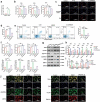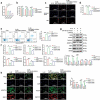LncRNA MINCR attenuates osteoarthritis progression via sponging miR-146a-5p to promote BMPR2 expression
- PMID: 35848848
- PMCID: PMC9645256
- DOI: 10.1080/15384101.2022.2099191
LncRNA MINCR attenuates osteoarthritis progression via sponging miR-146a-5p to promote BMPR2 expression
Abstract
The purposes of this study are to explore the function and regulatory mechanism of a novel lncRNA MYC-Induced Long non-coding RNA (MINCR) in osteoarthritis (OA). The expression of lncRNA MINCR, miR-146a-5p, and bone morphogenetic protein receptor 2 (BMPR2), Sry-type high-mobility-group box 9 (SOX9), collagen type II alpha 1 (COL2A1), Aggrecan, metalloproteinase with thrombospondin motifs-4 (ADAMTS-4), Matrix metalloproteinase 3 (MMP3), MMP13, COL2A1, and Aggrecan were determined using quantitative real-time PCR (qRT-PCR), western blot, immunohistochemistry (IHC) and immunofluorescence (IF) in vitro and in vivo. And distribution and expression of MINCR were examined by fluorescence in situ hybridization (FISH). Cell proliferation and apoptosis were detected by cell counting kit-8 (CCK-8) assay, 5-Ethynyl-2'-deoxyuridine (EdU) staining, Annexin V-FITC/Propidium Iodide (PI), and Terminal Deoxynucleotidyl transferase-mediated dUTP Nick-End Labeling (TUNEL) staining in vitro and in vivo. The anterior cruciate ligament transection (ACLT) rat model was constructed to analyze the MINCR/miR-146a-5p/BMPR2 axis in vivo. The cartilage degeneration was determined by pathological staining with Hematoxylin and Eosin (H&E) and Safranin O staining. The binding relationship between MINCR and miR-146a-5p, and between miR-146a-5p and BMPR2 were determined by a dual-luciferase reporter gene, RNA Immunoprecipitation (RIP) assay, and RNA-pull down assays. Here, MINCR and BMPR2 were downregulated whereas miR-146a-5p was upregulated in OA cartilage tissues compared with control as well as IL-1β-induced chondrocytes compared with normal chondrocytes. Function experiments indicated that MINCR upregulation promoted cell proliferation and inhibited apoptosis and extracellular matrix (ECM)-degeneration. We also proved the binding relationship between MINCR and miR-146a-5p, and the BMPR2 acted as a target of miR-146a-5p. Mechanism analysis using rescue experiments in vitro and in vivo, MINCR silencing reversed the effects of miR-146a-5p downregulation in OA. Overexpression of miR-146a-5p also reversed the function of BMPR2 overexpression in OA. These data indicated that MINCR prevented OA progression via targeting miR-146a-5p to promote BMPR2 expression.
Keywords: BMPR2; MINCR; Osteoarthritis; inflammation; miR-146a-5p.
Conflict of interest statement
No potential conflict of interest was reported by the author(s).
Figures








Similar articles
-
Circ_0008365 Suppresses Apoptosis, Inflammation and Extracellular Matrix Degradation of IL-1β-treated Chondrocytes in Osteoarthritis by Regulating miR-324-5p/BMPR2/NF-κB Signaling Axis.Immunol Invest. 2022 Aug;51(6):1598-1611. doi: 10.1080/08820139.2021.2001496. Epub 2022 Feb 17. Immunol Invest. 2022. PMID: 35172669
-
CircRNA circ_SEC24A upregulates DNMT3A expression by sponging miR-26b-5p to aggravate osteoarthritis progression.Int Immunopharmacol. 2021 Oct;99:107957. doi: 10.1016/j.intimp.2021.107957. Epub 2021 Jul 26. Int Immunopharmacol. 2021. PMID: 34325283
-
Circ_0022383 alleviates IL-1β-induced apoptosis, inflammation and extracellular matrix degeneration in osteoarthritis cell model by miR-3619-5p/SIRT1 axis.Int Immunopharmacol. 2022 Nov;112:109289. doi: 10.1016/j.intimp.2022.109289. Epub 2022 Oct 1. Int Immunopharmacol. 2022. PMID: 36194985
-
LncRNA MALAT1 promotes osteoarthritis by modulating miR-150-5p/AKT3 axis.Cell Biosci. 2019 Jul 1;9:54. doi: 10.1186/s13578-019-0302-2. eCollection 2019. Cell Biosci. 2019. PMID: 31304004 Free PMC article. Review.
-
A review on the role of MYC-induced long non-coding RNA in human disorders.Pathol Res Pract. 2023 Aug;248:154568. doi: 10.1016/j.prp.2023.154568. Epub 2023 May 24. Pathol Res Pract. 2023. PMID: 37285737 Review.
Cited by
-
Recent Therapeutic Strategies for Excessive Chondrocyte Death in Osteoarthritis: A Review.Orthop Surg. 2023 Jun;15(6):1437-1453. doi: 10.1111/os.13718. Epub 2023 Apr 18. Orthop Surg. 2023. PMID: 37073120 Free PMC article. Review.
-
Oncogenic roles and related mechanisms of the long non-coding RNA MINCR in human cancers.Front Cell Dev Biol. 2023 May 5;11:1087337. doi: 10.3389/fcell.2023.1087337. eCollection 2023. Front Cell Dev Biol. 2023. PMID: 37215074 Free PMC article. Review.
-
Biological functions and applications of LncRNAs in the regulation of the extracellular matrix in osteoarthritis.Front Cell Dev Biol. 2024 Jan 8;11:1330624. doi: 10.3389/fcell.2023.1330624. eCollection 2023. Front Cell Dev Biol. 2024. PMID: 38259516 Free PMC article. Review.
-
The emerging role of lncRNAs in osteoarthritis development and potential therapy.Front Genet. 2023 Sep 14;14:1273933. doi: 10.3389/fgene.2023.1273933. eCollection 2023. Front Genet. 2023. PMID: 37779916 Free PMC article. Review.
-
TRPS1 regulates the opposite effect of progesterone via RANKL in endometrial carcinoma and breast carcinoma.Cell Death Discov. 2023 Jun 21;9(1):185. doi: 10.1038/s41420-023-01484-0. Cell Death Discov. 2023. PMID: 37344459 Free PMC article.
References
Publication types
MeSH terms
Substances
LinkOut - more resources
Full Text Sources
Medical
Research Materials
Miscellaneous
